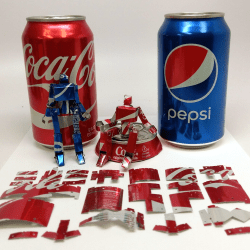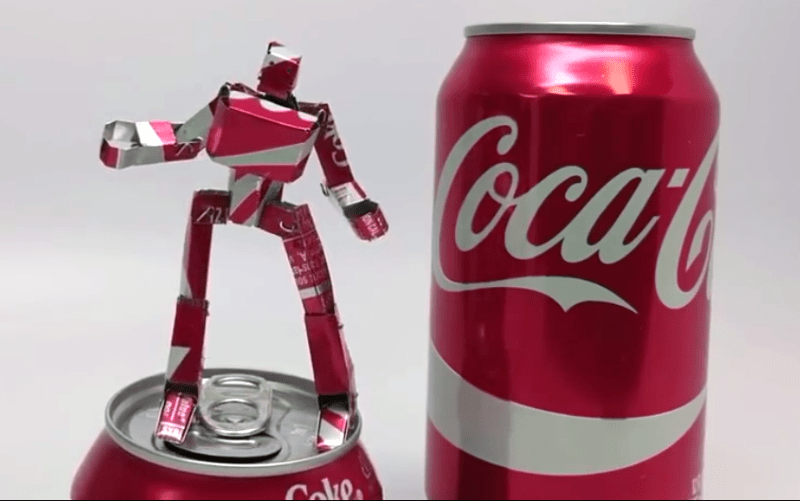 [apollocrowe] at Carbide 3D (a company that does desktop CNC machines) shared a project of his that spent years being not-quite-there, but recently got dusted off and carried past the finish line. His soda can robot action figures were originally made by gluing a paper design to aluminum from a soda can, but [apollocrowe] was never really able to cut the pieces as reliably or as accurately as he wanted and the idea got shelved. With a desktop CNC machine to take care of accurate cutting, the next issue was how to best hold down a thin piece of uneven metal during the process. His preferred solution is to stick the metal to an acrylic wasteboard with hot glue, zero high enough and cut deep enough to account for any unevenness, and afterwards release the hot glue bond with the help of some rubbing alcohol.
[apollocrowe] at Carbide 3D (a company that does desktop CNC machines) shared a project of his that spent years being not-quite-there, but recently got dusted off and carried past the finish line. His soda can robot action figures were originally made by gluing a paper design to aluminum from a soda can, but [apollocrowe] was never really able to cut the pieces as reliably or as accurately as he wanted and the idea got shelved. With a desktop CNC machine to take care of accurate cutting, the next issue was how to best hold down a thin piece of uneven metal during the process. His preferred solution is to stick the metal to an acrylic wasteboard with hot glue, zero high enough and cut deep enough to account for any unevenness, and afterwards release the hot glue bond with the help of some rubbing alcohol.
Assembly involves minor soldering and using a few spare resistors. A small spring (for example from a retractable pen) provides the legs with enough tension for the figure to stand by itself. The results look great, and are made entirely from a few cents worth of spare parts and recycled materials. A video of the process is embedded below, and the project page contains the design files.
We’ve seen empty soda cans CNC milled into a solder stencil before, but that project didn’t get into how they were securing the notoriously uneven material to the bed. If reuse of empty soda cans is your gig but you lack fancy CNC, projects like this decorative box show that great results can be obtained even with simple tools.
















I wonder if a LDF spoilboard + a blower would provide enough vacuum to hold down? Also, assembling those 0.1 mm thick parts is like assembling a toy made out of razor blades. Take care when doing so!
Yes! This may be the solution to the snowflake crisis, toys made out of razor blades! /s
You saw that /s right? Because there is a /s there, right at end of sentence, here, ^^^^
Maybe not overkill. The joints and use of srpings is interesting, but the value and the nicety in making things from the cans is the manual work and craftmanship associated with it. Making it machine-automated takes out the “wow, it´s hard to do” and turns it in another dollar-store cheap trinket.
Fails to explain this.
https://www.youtube.com/watch?v=LDMmcsH0fo8
Damn, next Bieber will want to marry her and 3D print her out at a 7-11 or something.
Internet: Japan. That’s all the explanation you need.
Curses, no react on my Idoru parallel…
Bro, do you even Gibson?
I’ve seen those made from spray paint cans and steel pop cans. Likely more durable than made from thin aluminum pop cans.
Can you order these and where from?
That is a crazy amount of work to cut out squarish shapes, but the stop-motion dance video at the end is pretty good.
Those are great designs but no need for the cnc cutting.
A template and scalpel would give the same result.
I’m guessing they used a CNC Mill as Carbide3D are a CNC machine manufacturer and wanted to show off their wares ;)
After making several of these Robots by hand (@1 hour handcutting time), and with the cnc mill (15 minutes) both take too long.
However, now that the CAD is proven I can get a roller die (3k) or steel rule die (@$400) made.
Oh, and CHEERS! Everyone! Happy Sunday.
Super awesome to be on Hackaday!
Cool!! No pun intended.
“Scissors Turn Empty Cans Into 1090Mhz Antenna”
Possibly of more general interest to HAD readers.
Yes, thanks!
If you are going to try and design these you should look at the unfold add-on in Blender 3D or even Pepakura.
Otherwise on Archive.org you can find a few (very old-school) books on sheet metal working and constructive geometry and shape development that show you how to merge two or more complex surfaces. They once designed all of their pipe and duct work that way, amazing skills, now it is all CAD and Boolean geometry before automated unfolding and rarely approaches the part count and fold efficiency of the work past masters achieved.
I do a lot of sheet metal design work in 2D for my job, and it can be really rewarding when some complex part with seven bends fits with the other three parts that have 4 bends each. It is prone to messing up though.
Also, Make123D is a very good, single purpose bit of software. I made this with it: http://i.imgur.com/1xCII6G.jpg
(Write up on imgur, for those interested: http://imgur.com/gallery/ccGTB)
That came out really well, I’m very impressed! Thanks for sharing.
your bear appears to be shedding.
Can’t help but wonder if this can be done with a vac bed and a carbide/hss drag knife.
But it’s a good example of how to hold down and work with thin stock.
Aluminum cans are thin and sharp, how many times did you cut your hands?
Not to worry, we have the antidote in the comments here, thick and dull.
It’s amazing creative work! Like it!
looks great.
Thank you so much … COOL JOB … greetings from Mexico…!!!